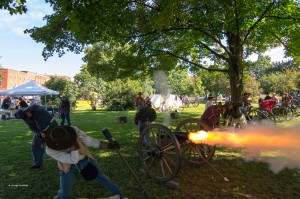ST. ALBANS — The Third Annual St. Albans Civil War Heritage Weekend held Saturday and Sunday, Aug. 17 and 18, 2013, on Taylor Park not only included an expanded historical view, but was greeted warmly by downtown businesses.

Members of the 9th Battalion Army of Northern Virginia fire their battery at Union forces in a mock battle in Taylor Park during the Aug. 17, 2013 morning artillery demonstration. The action took place during the Third Annual St. Albans Civil War Heritage Weekend. From left to right are: Skip Springer, Ilion N.Y., John Kirkham, Oneida N.Y., Adam Zamta, Utica N.Y., Battery Commander Major John Rathbun, Indian Lake N.Y., Bill Preston, Burlington, and Charles Shapley, Ilion, N.Y.
Photo by GEORGE OUELLETTE
The event this time added a representation of the roles Canada and Northern New York played in the war between the Union and the Confederates States.
The annual reenactment event, organized by the Champlain Valley Historical Reenactors in partnership with the St. Albans Historical Museum, creates a real-life look at how the Civil War was fought, who the men were, the weapons they used, the food they ate, and the conditions they endured.
It also brings dozens of historical reenactors, all volunteer, together for one common purpose – education. This weekend’s event had about 80 re-enactors from military units and the largest number of civilian participants ever.
Tents in which the soldiers camped were spread under trees at either end of the park. Artillery pieces roared during demonstrations and two cavalry horses trod on the park. Children marched in formation during Cadet Drills and Abraham Lincoln (portrayed by Bob Bushnell of Fletcher) gave a stirring closing address after the final event – a re-enactment of the South’s surrender at Appomattox in 1865.
The re-enactors here this weekend are a dedicated lot, who participate in all sorts of events.
Danny Reandeau of the 118th N.Y., said the original regiment mustered out of Tupper Lake and the surrounding Adirondack region.
While some of the today’s 118th’s members had come to the event in the past this was the first time the group set up camp here.
“We are a historical unit, we volunteer to go to schools, luncheons, and where ever there is interest to talk to the people about how bad the war was,” Reandeau said.
His commanding officer, Captain Pete Gilbert, who led Union infantry in drills on the park, agreed.
There were 618,000 casualties in the Civil War, over 204,000 died in battle, and the number that died from disease was more than double that.
“We offer historical information about several aspects of the Civil War, including military, civilian, artillery, apothecary, medical field hospitals, genealogy, Christian commission, and we offer interactive displays,” Gilbert said.
Gilbert explained that the 118th NY was needed as infantry during this year’s event, but it usually travels with its Burnett’s Battery display, which includes a mountain howitzer and two co-horn siege mortars.
“These were utilized for rough terrain areas such as mountains and cliffs, they were considered as flank guards, and were carried on horses,” Gilbert said of the mortars, which had no wheels.
Both men said they had ancestors who fought in the Civil War, both of whom were in the 106th.
Reandeau portrays his ancestor, Lewis Edward Benware, who was from Owl’s Head, N.Y., and served twice in the war. Unlike thousands of his fellow soldiers, Benware survived the war and in 1876 he met with many of their families to share his memories.
Gilbert said his great-grandfather was wounded twice and survived, but unfortunately after returning home and starting a family was accidentally killed from a kick to his head while shoeing a horse.
The men also share a commitment to help others connect and find information about ancestors that may have fought the Civil War.
Canada’s influence
On the other side of Taylor Park, the 27th Virginia Company M had set up camp under command of Major Rob McLachlan, of Montreal, Canada.
McLachlan offered curious visitors a wealth of information about the Canadian involvement.
“There were 50,000 or more Canadians who fought in the Civil War,” said McLachlan.
He felt it important to note that approximately 42,000 fought with the Union Army, and the other 8,000 to 10,000 men joined the Confederates.
“I actually have ancestors on both sides,” McLachlan said.
He explained that a number of things factored into the decision regarding which side the Canadian men joined, never mind the fact that the whole notion of fighting for the U.S. wasn’t even legal, as the country was still under British rule.
Canadians as a rule were opposed to slavery, but the Federal army offered enlistment bounties ranging from $200 to $1,200 per person, which were very hard to resist, especially with a life in farming paid.
“There were also friendships all along the U.S. and Canadian border with the textile industries, and wood and lumber trading,” McLachlan added.
Some men chose the Confederate side because of relatives that migrated to places such as New Orleans and Louisiana. The Maritime provinces began showing loyalty to the Confederates in a large part because of the struggle to maintain their own independence from Canada, so there was the trade with Canadian seaports acting as shipping agents for a supply of cotton, which was high in value due to the disruption of the war..
“Thirty-four Canadians won the U.S. Medal of Honor between the Army and the Navy,” McLachlan said.
“There were four Canadian men who made the rank of general within the federal forces,” he added.
There were about 10,000 Canadian casualties during the Civil War.
No matter which side they were on, however, re-enactors taking up roles in the living-history weekend appeared to be impressed with the turnout and with St. Albans itself.
Carl Marshall, of Malone, N.Y., a member of the 2nd Michigan who camped this time with the 118th N.Y. said, “I’ve been in St. Albans before. You know, stopping off for coffee on the way to Burlington.
“But this is really something,” he added, waving his arm in a sweeping motion from the St. Albans Historical Museum, across the park, and toward the new streetscape downtown where diners sat in tables on the sidewalk outside Twiggs.
As many as 250 to 300 attended individual Civil War demonstrations and the final event on Sunday, typically a slow day due to a shortened schedule of events also was well-attended. Re-enactors expressed appreciation for the welcome they received.
St. Albans resident, Capt. Steve Smith, of the 2nd Mississippi, who is a key organizer of CVHR involvement in the weekend, closed out the event by describing next year’s St. Albans Raid 150th Anniversary Commemoration which already has the support of the re-enactment community and is nearly three years in the planning.
Smith, who is deeply invested in planning for 2014 said he was relieved to have the third annual heritage weekend be so successful. Half-jokingly, he also added, “I’ll be glad to go back to work on Monday. It will be like getting some rest.”
The event was also a boon for local businesses. “I wouldn’t have imagined our downtown could have looked and felt so wonderful,” said Tom Murphy, owner of Twiggs. His business was full all weekend.
Murphy opened the combination pub and restaurant on Sunday anticipating runners in the half-marathon might want a post-run beer. “We were just stuffed with people,” said Murphy, adding that there were a lot of people from outside the area.
Marty Manahan, the city’s director of business development, said the merchants he spoke with over the weekend were very pleased with the traffic in their stores.
“Our downtown was filled both days and evenings,” said Manahan.
Manahan said he heard comments from visitors about returning next year for the anniversary event.
By ANN HAWKSBY
With contributions from Michelle Monroe
St. Albans Messenger















